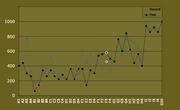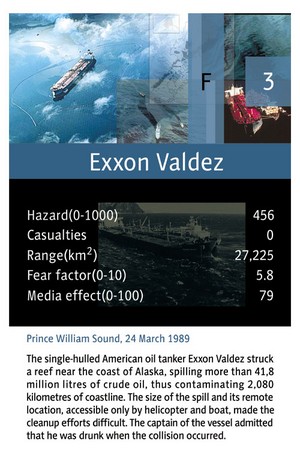|

On 24 March 1989, the single-hulled American oil tanker Exxon Valdez struck a reef in Prince William Sound, Alaska, spilling more than 41.8 million litres of crude oil, thus contaminating 2,080 kilometres of coastline.
Although not the largest accident of its kind, it was the deadliest to the wildlife. It killed an estimated 250,000 seabirds, 2,800 sea otters, 300 harbour seals, 250 bald eagles, up to 22 killer whales, and an unknown number of salmon and herring, thus affecting the delicate foodchain for many years to come.
Many factors complicated the recovery of the spill and thus contributed to the extent of the disaster. The size of the spill and its remote location, accesible only by helicopter and boat, made the clean-up efforts difficult.
In the aftermath of the accident, the US Congress agreed on the Oil Pollution Act of 1990, which required strengthened regulations on oil tanks vessels and oil tank operators.
Ten years later only the species of otters and eagles had recovered, according to government scientists. The Exxon company has established a wildlife fund but claims that everything is back to normal in the area.
The captain of the vessel has admitted to have been drunk on vodka when the collision occured, and the accident has been named the biggest drunk-driving accident in history.
Comment this page
 
Links and references:
Read the Amercian government's explanation:
http://www.epa.gov/oilspill/exxon.htm
Exxon Valdez and the double-hull revolution:
http://www.acpub.duke.edu/~msf/oil_spill_paper/
Read about the drunk driving captain:
http://news.bbc.co.uk/2/hi/americas/298608.stm
|

|
|



